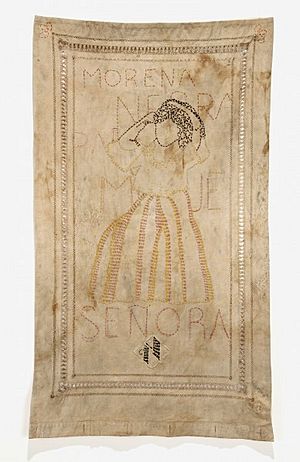Ana Gallum facts for kids
Ana Gallum, also known as Nansi Wiggins (born around 1755, died 1840), was a woman from Senegal. She was brought to Florida as an enslaved person. Later in her life, she became a landowner and even owned enslaved people herself.
Her story began like many others from Africa. She was kidnapped from her home and forced into the Transatlantic Slave Trade. This journey, called the Middle Passage, was very dangerous. However, Ana Gallum's life took a different path than most. She gained her freedom after a short time. She then married her former owner, Joseph "Job" Wiggins, who was an English landowner. They had six children together. After her husband passed away, Ana Gallum inherited his property. This included a large farm and many enslaved individuals. She managed this farm in what was then Spanish Florida. Historian Dr. Jane Landers, who has studied Gallum's life, said that Ana faced challenges but used the Spanish legal system to become secure.
Contents
Ana Gallum's Early Life
We don't know much about Ana Gallum's early years because there aren't many records. We do know she was born around 1755 in Senegal, Africa. When she was young, she was captured and sold to a trading company called Panton, Leslie & Company. She survived the difficult journey across the ocean on a slave ship. She arrived in St. Augustine, Florida. There, she was sold to Joseph "Job" Wiggins, an English landowner.
After some time, Ana and Joseph married in 1781. Their wedding was a Protestant ceremony. However, Spanish officials did not officially recognize this marriage. This was because it was not a Catholic ceremony, and the Spanish government was Catholic. Even so, they continued their lives together. Ana used her marriage to move from being a farm worker to managing the plantation.
Family and Property
Ana and Joseph had six children together. They had four daughters and two sons. All their children were born free under Spanish law. Ana had all her children baptized in the Catholic church in 1795 and 1797. This helped her children later in life. It allowed them to make good marriages and improve their financial situation under Spanish rule.
Ana and Joseph stayed together for 18 years. Joseph Wiggins died in 1797. He left all his property to Ana. This included the family estate, a furnished farm house, and the enslaved people who worked there. Ana became the head of the household. She continued to run the farm with help from her oldest son, Benjamin.
After her husband's death, Ana Gallum worked on the farm. She also bought and sold cattle and enslaved people. In 1799, two years after Joseph died, Ana had her seventh child, Pedro Cassaly II. She asked the Spanish courts for money to help raise him. But the courts said no. They saw that she was a wealthy woman because of her inheritance.
Using the Spanish Legal System
Ana Gallum lived in Florida when it was under Spanish rule. The rules for enslaved people were different there than in other parts of Colonial America. Spanish law, based on something called the Siete Partidas, gave some rights to enslaved people. Enslaved women were seen as needing protection, similar to children. They were protected from physical harm under Spanish law.
Marriages between people of different backgrounds were common in Spanish colonies. Historian Dr. Jane Landers explains that Spanish courts often supported the inheritance rights of women and children of African descent. This was true even if their parents were not legally married, as long as their relationship was publicly known.
After her husband's death, Ana went to court for financial help. This shows she understood the Spanish legal system. She knew it could be a tool to help her. Even though she didn't get the money she asked for, it proved she was a part of Spanish society.
Ana Gallum's Later Life and Death
We don't have much information about Ana Gallum's death. The only record is from the United States Federal Census of 1840. This census lists her under her married name, Nansi Wiggins. Based on her estimated birth year of 1755, she would have been about 85 years old when she died.
Her Legacy
Ana Gallum lived most of her life as a free woman in the Spanish colonies. She had many of the same rights as other women under Spanish rule. This also helped her give her children a much better life.
Her oldest son, Benjamin, became a translator for local Indigenous tribes. He spent time with the Seminoles. He later married the daughter of a wealthy landowner, Felipe Edinborough. Her oldest daughter, Beatriz, married Charles W. Clarke. He was the younger brother of a well-known person, George J. F. Clarke. Beatriz, like her mother, had six children. Beatriz and Charles moved to Fernandina, Amelia Island. There, they gained a better social standing as free Black people under Spanish rule.
Another daughter, Abigail Juana (called "Jennie"), also moved to Fernandina. She and several of Ana's other children became landowners. Most of them later blended into white society. Ana Gallum herself moved to Fernandina from Palatka in 1811. She had lost the Wiggins’ plantation because the land wasn't being used enough for farming. She bought three lots of property for herself and her youngest son, Pedro Cassaly II.
When Florida became part of the United States after the Adams–Onís Treaty of 1819, Ana and her children stayed. Many other free enslaved people moved to Cuba, but they chose to remain. Spanish law saw slavery as a "changeable legal situation." It wasn't strongly linked to a person's race. Because of this, Ana Gallum was able to use the Spanish legal system. She secured a life of moderate wealth for herself and an easier life for her children.
See Also
- Anna Madgigine Jai Kingsley
- Suzanne Amomba Paillé
- Elisabeth Samson



